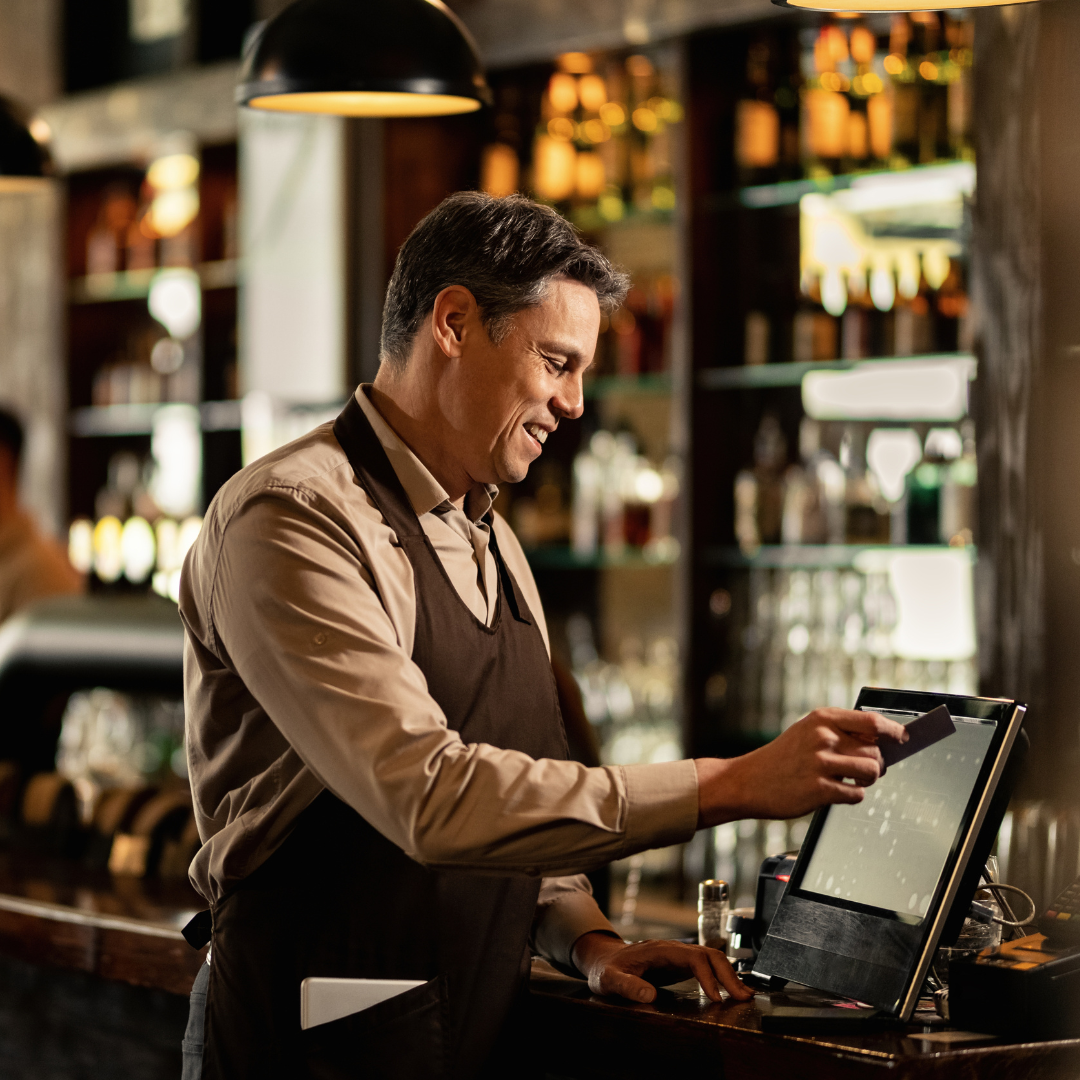What if we told you that you may be missing out on great uses for your (POS) point-of-sale system?
These uses can drive more revenue and make your business run smoother. So it’s too bad many businesses only think of their POS as a way to take payments.
Let’s clear that myth up right now by starting with the six keys to maximizing your point-of-sale system.
Ways To Maximize A POS
- Accept multiple payment types
- Inventory management
- Customer management
- Employee management
- Reporting and analytics
- Mobility and integration
Here is the breakdown of those six.
Choosing a point-of-sale system that offers more than a few payment types means you can reach more customers. Why? One, there are more payment options publicly available than in past years. Two, as the public finds out about new ways to pay, they are eager to try fresh options that fit their lifestyle and shopping habits.
We’ll show examples of this in a minute when we look at retail and restaurant POS specifically.
As for inventory, customer, and employee management, think how much more efficient your operation could run when you can reduce repetitive tasks. POS software can automate manual tasks, saving you time and effort daily, which really adds up over the course of a year.
Then you have reporting and analytics that can impact decision-making in your business. What kind of decisions? You name it!
From ordering to hiring to scheduling to pricing, analytics are a business owner’s best friend. And those capabilities are inside your payment processing POS (if not, then ask your provider how to access them, by upgrading or downloading updates to your system, for example).
Last on the list of six is mobility and integration. You want to ensure you are maximizing the connections your point-of-sale system has with other business software. This cuts down on mistakes and repetitive work as well. The mobility aspect means customers can check out easier as staff bring handheld payment terminals to customers or offer tabletop terminals (if you own a restaurant).
Oh, and mobility can also relate to cloud services that don’t keep your data tied down to a stationary location (helpful for multiple locations or franchises).
Alright, you have actionable ways to improve your business with those six things and now we can move on to POS software and hardware.
What Problems Pop Up With POS Hardware And Software?
If you have a reliable merchant services provider, they should keep you up-to-date with modern hardware and POS software.
In case you’re not getting good service from your processor, look out for these common POS hardware issues:
- Power outages, surges, battery failures, or loose connections can cause point-of-sale systems to shut down unexpectedly, lose data, or damage components.
- Display issues that make it hard to see info on the screen and can disrupt touchscreen function.
- Printer problems like jams or poor printing making receipts illegible.
- Barcode scanners not working properly.
It’s important to have rugged but sleek-looking payment equipment so it stands up to daily use without those failures above.
What about those POS software issues that are so common?
- Bugs, crashes, freezes, or slow loading times can cause inaccurate data, security breaches, or annoy customers.
- Poor connectivity, slow speeds, or downtime make checkouts slow and can cause lost sales.
- Data loss via corrupted files, deleted records, or stolen information due to lack of backups or solid security.
- Weak encryption, firewalls, and PCI compliance across all POS components is a recipe for cyberattack disasters.
Contact your payment provider in the early stages of any software issues so you can nip them in the bud. The same goes for the next topic…

Point-Of-Sale Integrated Payment Solutions
A modern payment processing company loves helping customers with integrated payment solutions because it means the business is able to scale. This helps the processor because they, too, profit from more sales rolling in — a win-win.
You may be wondering how integrated payment solutions help produce business growth. Well, there are several factors.
There are the time-savings from less manual data entry we noted. But then you have a seamless connection to your CRM (customer relationship management software), for example. With that connection, you open up new doors for marketing, sales promotions, lead generation via referrals, and more.
Cash flow can improve as well, as you no longer have to manually enter invoices and send them out the old-fashioned way. You can use modern tools to work smarter rather than harder, while getting paid faster. Yes!
Your labor costs can also be reduced as technology eliminates work your staff was once tasked with, not to mention recovering losses from error-prone manual data entry. With integrated payment solutions, you’re harnessing the power of technology and freeing yourself and your staff to do more meaningful work.
Maybe the most vital aspect here is how modern payment systems use advanced security like encryption, tokenization, and fraud detection. When integrated with other platforms, this should protect sensitive payment data wherever it moves across your systems.
With a good overview of point-of-sales systems, it’s time to dig into retail POS systems then we’ll get to restaurant POS systems.
Retail POS Systems
POS systems can be used in physical stores or online or both!
The possibilities are endless when you have an online store to complement your brick-and-mortar location and vice versa, but that’s a topic for another day.
The best features of retail POS systems are as follows:
- Insights into sales data, profit margins, peak hours, customer behavior, and marketing trends (just the tip of the insight iceberg)
- Ability to easily build customer loyalty into purchases
- Adjustable role-based permissions, staff performance metrics, clock in/out, and payroll integration
- Modern retail POS systems should enable complementary online/in-store operations (buy online/pickup in-store, cross-channel promotions, and a consistent experience across touchpoints)
The truth is that you may not need every feature provided by your point-of-sale system. However, carefully considering which ones will help you scale your business is smart. Start by doing a mental walkthrough of your customer experience. Better yet, map it out with tools like the ones linked below.
Tool list for monitoring and enhancing customer experience.
What are some differences in features needed for a restaurant compared to retail POS? We’ll dive into that in one sec. First, a few notes on POS marketing.
POS Marketing
Please take note of this phrase – POS marketing. It may well be your biggest leverage for increasing sales. Plus, it can be your key advantage over other businesses that don’t take this one little step that leads to growth.
POS marketing, in simple terms, is nudging customers to take an action while they are checking out. Yes, that desired action is often them buying another item or two. That’s the reason grocery checkout lanes have candy, magazines, and ice-cold drinks conveniently available. If they make an extra $3.25 for only one out of seven customers, that adds up over the course of just one day!
Yet, don’t overlook other actions customers can be prompted to take at checkouts that benefit your business. You could ask them to sign up for email discounts, for one. Building an email list is often cited as the most profitable marketing channel ($36 ROI to $1 spent, according to general reports).
POS marketing tactics could also nudge customers to sign up for a loyalty program, shop at your other location, try a sample of a new item, visit a fellow business owner’s store — see the endless opportunities?
Moving on to…
Restaurant POS Systems
Owning a restaurant can be stressful. So why not reduce stress by making workflows actually flow?
Five ways a restaurant can better utilize its industry-specific point-of-sale system:
- Super-easy interface to make training a breeze and help new employees get up to speed fast
- Innovative order management to eliminate order mistakes and smooth the path of order information from table to kitchen (and from food delivery app to kitchen)
- Enhanced table management leads to more patrons being served and profits rising
- Replace outdated paper menus that may have old pricing or specials no longer available
- Quick tipping features with preloaded tip percentages get diners happily on their way, and reports show preloaded tip amounts increase tips for waiters/waitresses
Don’t forget that POS marketing strategies can and should be considered for your restaurant business too. It’s a flexible marketing strategy. Just hone it to your customer base.
Sign up with National Processing. Save money, time, and avoid payment hassles.
What if you don’t know your customer base that well or your cafe has only been open a short time?
Simple — use your restaurant POS to reveal customer data and patterns!
Now that you know several new point-of-sale features and uses you might have overlooked, we will conclude with our popular FAQ section in case there are more POS questions popping in your head.
FAQ POS Systems
Is an industry-specific POS necessary?
Yes — if you are seeing high sales volume as it can improve efficiency. No — if you’re starting out and need to conserve funds for more pressing needs. Shop around to compare processing rates and at the same time, ask providers about industry-specific POS features.
What are key advantages of a cloud-based point-of-sale system?
1) Lower upfront costs and scalability. 2) Increased accessibility and mobility. 3) Automatic software updates and data backups.
What can go wrong with a mobile POS system?
Unattended terminals could be accessed by anyone. Untrained employees could unknowingly give access to mobile POS to fraudsters posing as vendors, service personnel, or authority figures. Also, weak passwords allow for unauthorized use or hacks.





